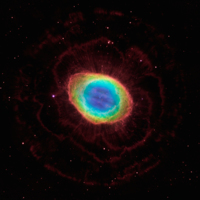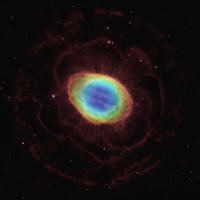Hubble Reveals the Ring Nebula's True Shape
Dublin Core
Title
Subject
Description
In this composite image, visible-light observations by NASA's Hubble Space Telescope are combined with infrared data from the ground-based Large Binocular Telescope in Arizona to assemble a dramatic view of the well-known Ring Nebula.
Called a planetary nebula, the Ring Nebula is the glowing remains of a Sun-like star.
The object is tilted toward Earth so that astronomers see the ring face-on. The Hubble observations reveal that the nebula's shape is more complicated than astronomers thought. The blue gas in the nebula's center is actually a football-shaped structure that pierces the red doughnut-shaped material. Hubble also uncovers the detailed structure of the dark, irregular knots of dense gas embedded along the inner rim of the ring. The knots look like spokes in a bicycle. The Hubble images have allowed the research team to match up the knots with the spikes of light around the bright, main ring, which are a shadow effect.
The faint, scallop-shaped material surrounding the ring was expelled by the star during the early stages of the planetary nebula formation. This outer material was imaged by the Large Binocular Telescope.
Most Sun-like stars become planetary nebulae at the end of their lives. Once a star consumes all of its hydrogen, the nuclear fuel that makes it shine, it expands to a red giant. The bloated star then expels its outer layers, exposing its hot core. Ultraviolet radiation from the core illuminates the discarded material, making it glow. The smoldering core, called a white dwarf, is the tiny white dot in the center of the Ring Nebula.
The Ring Nebula is about 2,000 light-years away in the constellation Lyra. The nebula measures roughly one light-year across.
The Hubble observations were taken Sept. 19, 2011, by the Wide Field Camera 3. The Large Binocular Telescope data were taken June 6, 2010. In the image, the blue color represents helium; the green, oxygen; and the red, hydrogen.
The Large Binocular Telescope is part of the Mount Graham International Observatory in Arizona.
ABOUT THE OBJECT
Object Name:
Ring Nebula, M57, NGC 6720
Object Description:
Planetary Nebula
Object Position:
R. A. 18h 53m 35.07s
Dec. 33° 1' 45.03"
Constellation:
Lyra
Distance:
2,300 light-years (700 parsecs)

